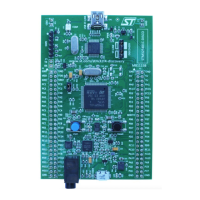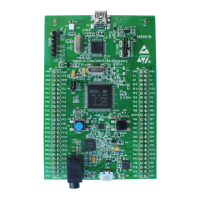Digital filter for sigma delta modulators (DFSDM) RM0402
356/1163 RM0402 Rev 6
SPI data input format operation
In SPI format, the data stream is sent in serial format through data and clock signals. Data
signal is always provided from DATINy pin. A clock signal can be provided externally from
CKINy pin or internally from a signal derived from the CKOUT signal source.
In case of external clock source selection (SPICKSEL[1:0]=0) data signal (on DATINy pin) is
sampled on rising or falling clock edge (of CKINy pin) according SITP[1:0] bits setting (in
DFSDM_CHyCFGR1 register).
Internal clock sources - see SPICKSEL[1:0] in DFSDM_CHyCFGR1 register:
• CKOUT signal:
– For connection to external Σ∆ modulator which uses directly its clock input (from
CKOUT) to generate its output serial communication clock.
– Sampling point: on rising/falling edge according SITP[1:0] setting.
• CKOUT/2 signal (generated on CKOUT rising edge):
– For connection to external Σ∆ modulator which divides its clock input (from
CKOUT) by 2 to generate its output serial communication clock (and this output
clock change is active on each clock input rising edge).
– Sampling point: on each second CKOUT falling edge.
• CKOUT/2 signal (generated on CKOUT falling edge):
– For connection to external Σ∆ modulator which divides its clock input (from
CKOUT) by 2 to generate its output serial communication clock (and this output
clock change is active on each clock input falling edge).
– Sampling point: on each second CKOUT rising edge.
Note: An internal clock source can only be used when the external Σ∆ modulator uses CKOUT
signal as a clock input (to have synchronous clock and data operation).
Internal clock source usage can save CKINy pin connection (CKINy pins can be used for
other purpose).
The clock source signal frequency must be in the range 0 - 20 MHz for SPI coding and less
than f
DFSDMCLK
/4.
Manchester coded data input format operation
In Manchester coded format, the data stream is sent in serial format through DATINy pin
only. Decoded data and clock signal are recovered from serial stream after Manchester
decoding. There are two possible settings of Manchester codings (see SITP[1:0] bits in
DFSDM_CHyCFGR1 register):
• signal rising edge = log 0; signal falling edge = log 1
• signal rising edge = log 1; signal falling edge = log 0
The recovered clock signal frequency for Manchester coding must be in the range
0 - 10 MHz and less than f
DFSDMCLK
/6.
To correctly receive Manchester coded data, the CKOUTDIV divider (in
DFSDM_CH0CFGR1 register) must be set with respect to expected Manchester data rate
according formula:
CKOUTDIV 1+()T
SYSCLK
×()T
Manchester clock
2 CKOUTDIV× T
SYSCLK
×()<<

